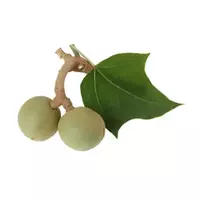Kukui nuts

If the fruit of the Australian plant macadamia is called the "king" in the nut world, then the kukui nut is called nothing more than "duke" from the Hawaiian Islands. We think most of our latitudes have never heard of the existence of the kukui nut, let alone that few who have seen on sale or tasted an incredibly healthy food. Kukui nuts are fruits of the evergreen candle tree, a plant that is common in tropical climates.
It is believed that the birthplace of kukui nuts is Panama. Nowadays, the evergreen candle tree grows and bears fruit with kukui nuts in Indonesia, Panama, Brazil, as well as in Madagascar, the Caribbean or Hawaiian islands. Kukui nuts have been known to the indigenous people of Panama since ancient times. In the Age of Great Geographical Discoveries, European sailors began to gradually explore uncharted lands.
Having landed on Panama, the colonialists received offerings from the locals, various delicacies, among which were the fruits of the candle tree kukui nuts. A new type of nut came to the taste of Europeans and soon the fame of the new delicacy spread around the world. In addition to the name officially adopted in scientific circles, kukui nuts have a number of other names. For example, kukui nuts are called Indian walnuts, as well as candle tree nuts or kemiri.
Kukui nuts have found widespread use in the cooking of those countries in which the candle tree grows. Only heat-treated kukui nuts are eaten. The thing is that fresh kukui nuts contain carcinogenic and poisonous substances that are destroyed under the influence of temperature. Usually, kukui nuts are used to make healing oil, as well as all kinds of sauces.
Pre-fried candle tree nuts are added to salads, snacks, first and main courses. In addition, kukui nuts often become an important ingredient in the composition of national confectionery and sweets that are produced in Indonesia, India, Panama, Hawaii, as well as in Brazil. Connoisseurs and foodies argue that the taste of cookie nuts is not particularly different from macadamia. It is worth noting that kukui nuts and macadamia have not only similarities in taste, but also in appearance.
Kukui nuts are distinguished by their small fruit size, as well as white pulp and delicate nut taste. based on the fruits of a candle tree making kukui oil, which also has unique beneficial properties and healing characteristics. Kukui nuts have been used in cooking and folk medicine in the Hawaiian Islands since ancient times.
However, the tradition of preparing the most famous Hawaiian seasoning called "inamona, " the main ingredient of which is kukui nuts, has survived to our time. Therefore, if you ever get to visit the beautiful and interesting from the point of view of cooking and history of the Hawaiian Islands, do not forget to taste the cooked kukui nuts and be sure to bring home a fragrant and surprisingly healthy seasoning "inamona. "
kukui nuts 620 kCal
Energy value of kukui nuts (Ratio of proteins, fats, carbohydrates - ju):
Proteins: 7.91 g (~ 32 kCal)
Fats: 75.77 g (~ 682 kCal)
Carbohydrates: 5.22g (~ 21kCal)
Energy ratio (bj | y): 5% | 110% | 3%
 Español
Español Français
Français Português
Português Русский
Русский 简体中文
简体中文 繁體中文
繁體中文 日本語
日本語 한국어
한국어 العربية
العربية Türkçe
Türkçe Қазақ
Қазақ Deutsch
Deutsch Italiano
Italiano Українська
Українська
